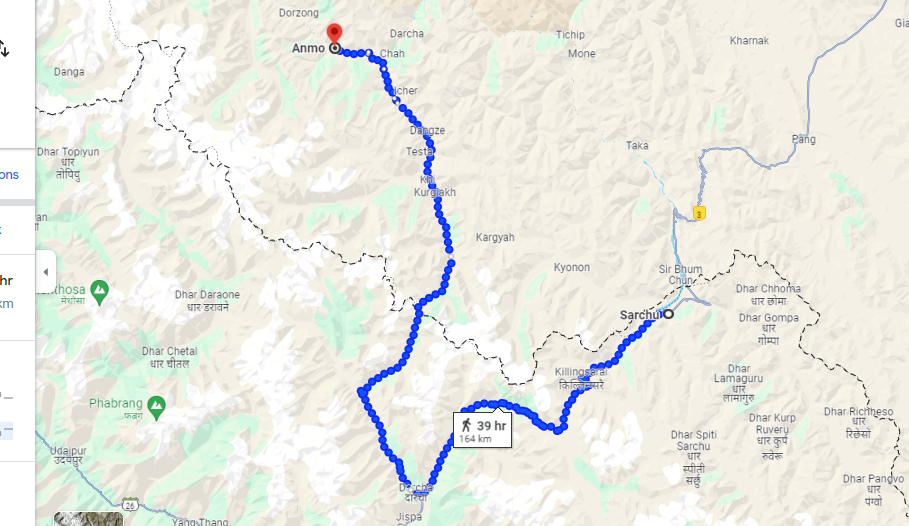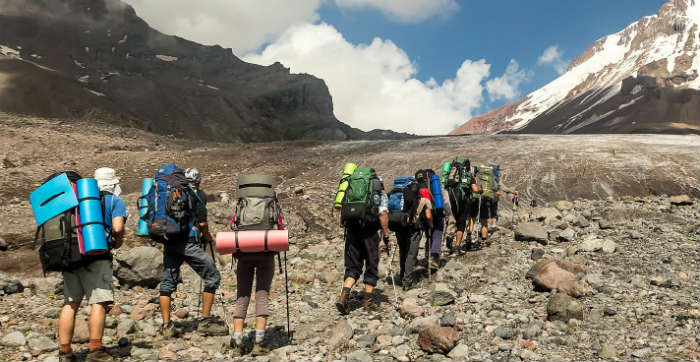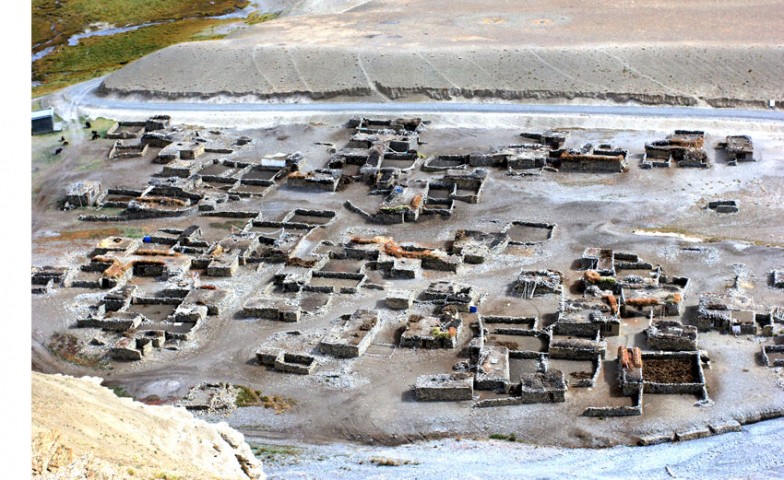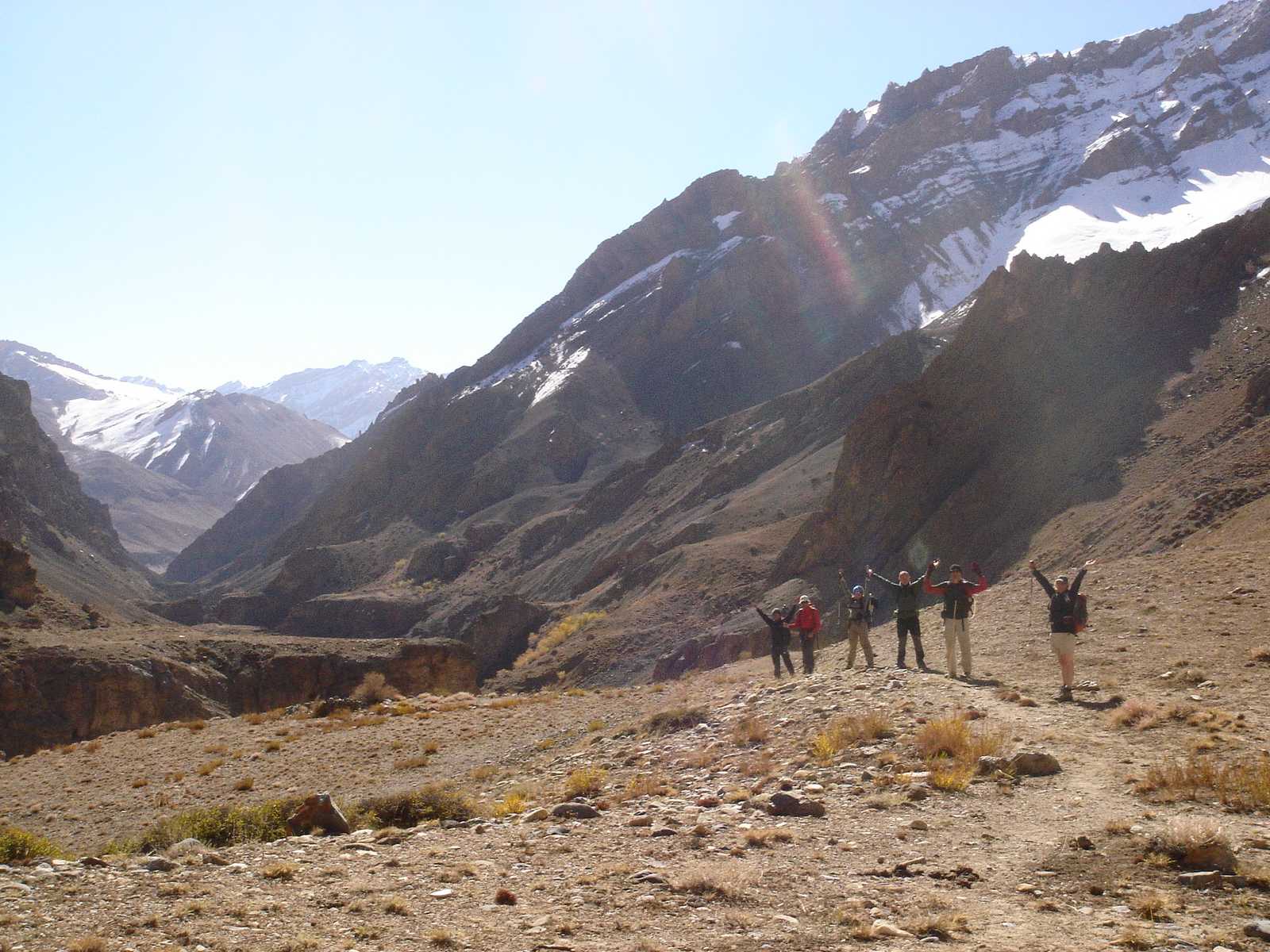Anmo to Serchu Trek – Trek No 10
Trip Overview
Anmo to Serchu Trek
The Anmo to Serchu trek is also a breathtaking adventure that takes avid trekkers through some of the most stunning landscapes of the Ladakh region in northern India. Covering a distance of approximately 90 kilometers, this trek offers a challenging yet rewarding experience for those seeking an adrenaline-pumping escapade amidst the Himalayan terrain. Starting from Anmo, a quaint village also located in the Ladakh region, trekkers set out on a journey that encompasses diverse landscapes, from lush green meadows to barren high-altitude deserts. The trek provides a unique opportunity to witness the region's rich cultural heritage and interact with the local communities, primarily of Ladakhi descent, known for their warmth and hospitality. The initial leg of the trek leads through picturesque valleys and verdant meadows adorned with colorful wildflowers, creating a postcard-worthy scenery. Trekkers traverse along gushing rivers and negotiate gentle ascents and descents, gradually acclimatizing to the increasing altitude. As the trail progresses, the landscape transforms dramatically into a high-altitude desert, showcasing vast expanses of arid terrain and towering mountain ranges. Trekkers are met with the formidable challenges of navigating rocky terrain and steep slopes, adding an element of excitement to the adventure. The highlight of the trek is reaching the renowned Tsokar Lake, a shimmering saltwater lake surrounded by majestic mountains. The lake is a haven for migratory birds and offers a mesmerizing sight, especially during sunrise and sunset. The final stretch of the trek takes trekkers to Serchu, another small village, where the journey culminates. Serchu boasts a unique charm and provides trekkers with an authentic Ladakhi experience, allowing them to immerse themselves in the local culture and hospitality.Conclusion and Summary
Overall, the Anmo to Serchu trek is a challenging yet exhilarating journey that allows trekkers to delve into the diverse landscapes, culture, and beauty of the Ladakh region. It's a trek that promises unforgettable memories and a deeper connection with the Himalayas, making it a must-do for adventure enthusiasts seeking an extraordinary trekking experience.Trip Highlight
The Anmo to Serchu trek, also known as the Anmo to Sarchu trek, is a thrilling adventure through the remote and rugged landscapes of the Indian Himalayas. Here are some highlights you might experience during this trek:
- Scenic Beauty: The trek offers breathtaking views of the surrounding Himalayan peaks, including snow-capped mountains, verdant valleys, and pristine alpine meadows. The landscape varies from lush greenery to barren stretches, providing a diverse visual treat for trekkers.
- Remote Wilderness: This trek takes you through some of the most remote and least-explored regions of the Indian Himalayas. You’ll encounter vast expanses of untouched wilderness, far from the reach of modern civilization, which adds to the sense of adventure and exploration.
- High-altitude Passes: The trek involves crossing several high-altitude passes, including the Phirtse La Pass, which stands at an elevation of over 5,582 meters above sea level. These passes present a challenging yet rewarding experience for trekkers, offering panoramic views of the surrounding mountains and valleys.
- Camping under the Stars: Camping is an integral part of the trekking experience, allowing you to immerse yourself fully in the natural beauty of the Himalayas. Spend your nights under the starry sky, surrounded by the tranquility of the mountains, and wake up to stunning sunrise views.
- Crossing Rivers and Streams: The trek involves crossing several rivers and streams, adding an element of excitement and adventure to the journey. Trekkers must navigate these water bodies carefully, sometimes using makeshift bridges or stepping stones, which adds to the thrill of the trek.
- Interaction with Locals: Along the way, you’ll have the opportunity to interact with local villagers and nomadic communities who inhabit the region. Learn about their traditional way of life, cultural practices, and unique customs, gaining insights into the rich heritage of the Himalayan people.
- Wildlife Encounters: The region is home to a variety of wildlife, including rare Himalayan species such as snow leopards, ibex, and Himalayan wolves. While spotting these elusive creatures is rare, the trek offers opportunities for birdwatching and encountering other wildlife species amidst their natural habitat.
- Physical Challenge: The Anmo to Serchu trek is a challenging endeavor that requires a good level of physical fitness and stamina. Trekkers will encounter steep ascents and descents, rocky terrain, and unpredictable weather conditions, making it a test of endurance and resilience.
- Cultural Immersion: Explore remote Himalayan villages and gain insights into the local culture and way of life. Visit ancient monasteries, interact with Buddhist monks, and immerse yourself in the spiritual ambiance of the region.
- Sense of Accomplishment: Completing the Anmo to Serchu trek is a rewarding achievement that leaves trekkers with a sense of accomplishment and fulfillment. The rugged beauty of the Himalayas, coupled with the physical and mental challenges of the trek, create lasting memories and a profound connection with nature.
Itinerary
Upon arrival Leh airport, pick-up and transfer to hotel. After tea/coffee rest in hotel to get acclimatization. Evening walking walking tour in Leh bazaar. Overnight at hotel.
Drive by car from Padum till the very end of the road (in 2012 it was up till only Anmo). An early start might offer you more time for sightseeing of the gompas on the way like Bardan and Mune. At the end of the road, you’ll meet the horses and you’ll start from the left side of the river. The path leads high along the river through small villages/houses. You’ll finish the first trekking day in the district main quarter of Cha, a bigger village at 3.900 m. You can choose if you want to put up the tent or prefer one of the comfortable homestays to experience a little more of the life of the villagers.
(If you want, you can add a day here trekking to Phuktal with its famous Gompa and walk back to Purne, walking-time around 4 hrs. In total, giving enough time to explore the monastery as well. The walking-time for the next day will be 1 hr lesser from here)
Get down to the bridge, cross the river and climb up again. The path will lead you high above the river through the villages of Yal, Testa und Kuru. It is a nice and easy walk. Just before Tangtse there is again a small bridge to cross the river. Tangtse is a village located at around 4.000 m with 4 x 3-4 houses close together and huge fields around. There is an empty gompa high above th e village.
Continue on the same side of the river for the next 1-1.5 hours. You’ll reach Thabley, which consists of 2 houses. There you’ll enter a gorge ascending up into the mountains. Stay mostly on the left side, but sometimes you’ll have to cross (when there’s not much water, it’s easily done by jumping). Then you’ll leave the gorge on a high trail leading over ridges and back to the river at Zinchen at 4.600 m. You can either pitch your tent there or go a little higher, but there are only small spots for 2-3 tents.
Get up early in the morning since the trek towards and over the pass is quite long. Just keep on following the river up till you reach a nice place to take a rest and then descend down the pass. The climb is a little steeper until the top of the 5.582 m high pass, Phirtse-la. There you’ll have a spectacular view of the surroundings. Find a proper path to descend slowly downwards until you reach a broader valley called Churmik Marpo at 4.750 m. Camp there.
Follow the river down on the left side. You’ll see many marmot-holes, but very rarely one spots these shy animals. Before the river runs through a small gorge, you’ll have to cross it either on horseback or walk through the water. Continue on that side until the river flows into the bigger Lingti-River at Kham Kherab. There you’ll have to cross again. Kham Kherab is at 4.470 m and from here on, it is more or less like flat walking with only short ascents and descents. There are plenty of camping-possible sites along the Lingti-River. We suggest you go to Umlung at 4.440 m.
You continue walking on the right side of the Lingti-River (in the Olizane-map there is a path on the other side, too, which is wrong). On reaching the junction you could decide to have a long way to Killang Serai or you could continue just to Sarchu. There you’ll meet the Tsarap River, which has to be crossed and after that you’ll reach Sarchu at 4.300 m with a lot of Dhabas that offer food and night-shelter. From here, you can continue by road either to Leh or Keylong.
The drive from Sarchu to Leh is a spectacular journey through the rugged and mesmerizing landscapes of the Indian Himalayas. Starting from Sarchu, a high-altitude camping site nestled between Himachal Pradesh and Ladakh, the route offers breathtaking views of towering mountains, deep valleys, and barren expanses. As you embark on this drive, you’ll traverse through diverse terrain, including high mountain passes and winding roads carved along the cliffsides. One of the highlights of the journey is crossing the formidable Tanglang La Pass, one of the highest motorable passes in the world, standing at an elevation of over 5,300 meters (17,480 feet) above sea level. Along the way, you’ll pass by picturesque mountain villages, shimmering alpine lakes, and Buddhist monasteries perched atop rocky outcrops, each adding to the enchanting scenery. The drive is not only a visual feast but also a test of endurance as you navigate through the high-altitude terrain and unpredictable weather conditions. Finally, after several hours of exhilarating travel, you’ll arrive in Leh, the vibrant capital of Ladakh, where you can unwind, explore the local culture, and reflect on the unforgettable journey through the heart of the Himalayas.
The final departure from Leh to Delhi typically involves a journey back from the remote Himalayan region to the bustling capital city of India. Here’s a detailed description of what this journey might entail:
After bidding farewell to the enchanting landscapes of Leh, travelers usually begin their departure day by checking out from their accommodation in Leh and heading to the Leh Kushok Bakula Rimpochee Airport. This airport, located about 3.5 kilometers from the city center, serves as the primary air gateway to the region.
Upon reaching the airport, travelers proceed through security and check-in procedures, ensuring they have all necessary travel documents, including boarding passes and identification. It’s essential to arrive at the airport well in advance of the scheduled departure time to allow for security checks and boarding procedures.
As the departure time approaches, travelers board their flight bound for Delhi. The flight from Leh to Delhi typically offers stunning aerial views of the majestic Himalayan peaks, including glimpses of snow-capped mountains and rugged terrain below.
During the flight, passengers have the opportunity to relax and reflect on their unforgettable experiences in Leh and the surrounding Himalayan region. Many travelers take this time to review photographs, journal their memories, or simply enjoy the scenic views outside their windows.
Upon arrival at Indira Gandhi International Airport in Delhi, travelers disembark from the aircraft and proceed through the airport’s arrival procedures. This includes collecting luggage from the baggage claim area and clearing through customs and immigration if applicable.
After exiting the airport, travelers have several options for transportation to their final destination within Delhi or onward travel to other parts of India. This may include arranging for a taxi or rideshare service, utilizing public transportation such as the Delhi Metro, or coordinating with a pre-arranged transfer service.
Departures & Availability
The set departure dates listed are specially quoted and specified for group joining option. Let us know if the set departure dates are not suitable for you- another dates which are suitable for you can certainly be added by us.
Check Available Dates
| Start Date | Price | Availability |
|---|
All trip prices are per person based on double occupancy, are subject to change without notice and do not include airfare. All prices and fares are quoted in U.S. dollars.
Price include
- All transportation by Toyota Qualis, Innova or Scorpio.
- Two men tent, Kitchen and dinning tents.
- Kitchen equipments and Toilet Tent.
- Stool, Table and mattresses.
- Food veg and non-veg.
- Cook, helper and guide.
- Ponies for Luggages for Trekking with Camping.
- Ponies/Potters for Luggages for Trekking with Homestay.
- Monument entrances, wild life fees and camping charges.
- GST
Price Excludes
- Any flight tickets and any Accommodation except Padum & Kargil.
- No accommodation in Leh & Manali is included in Trekking Packages.
- Sleeping Bags, trekking shoes and clothing.
- Any Kind of Personal Expenses or Optional Tours / Extra Meals Ordered
- Any thing not specifically mentioned under the head “Prices Included”.
- Tips, Insurance, Laundry, Phone Calls.
- Any Kind of Drinks (Alcoholic, Mineral, Aerated)
- Cost incidental to any change in the itinerary/ stay on account of flight cancellation due to bad weather, ill health, roadblocks and/or any factors beyond control.
Gears And Equipment
Trip Information
Anmo to Serchu trek is bit challenging as it is done at high altitude. Best time to do this trek is from Mid June to September. Highest Point of the trek is Phitse La located at 5,582m. This trekking is mainly focusing on Landscape, villagers, high pastureland and its Landscape. Trekking sector: trek anmo/Tangtse/zingchen/phitse la/ chumik marpo/serchu,
It is a 9 days trek strating from Anmo to Cha. Morning drive from Padum till the very end of the road. There you’ll meet the horses and you’ll start your walk. If you want, you can add a day here trekking to Phuktal with its famous Gompa and walk back to Purne, walking-time around 4 hrs. In total, giving enough time to explore the monastery as well. The walking-time for the next day will be 1 hr lesser from here. Leave Cha next morning to Tangtse by crossing several villages like Yal, Testa and Kuru. Continue your walk to Zinchen on next morning along gorge and villages.Next day leave for Churmik Marpo by crossing Phirtse La located at 5582 m. From there you’ll have spectacular view of the surroundings. Night camp at broader valley called Chumik Marpo at 4750 m. From Churmik Marpo to Umlung you will have to walk along river untill it flow into bigger Lingti river at Kham Kherab. There are plenty of camping-possible sites along the Lingti-River. We suggest you go to Umlung at 4.440 m. Next day walk to Sarchu along Lingti River. On reaching the junction you’ll be greet by another river called Tsarap, which has to be crossed and after that you’ll reach Sarchu at 4.300 m with a lot of Dhabas that offer food and night-shelter. From here, you can continue by road either to Leh or Keylong
Anmo to Serchu Trek Route Map

FAQS
Lorem Ipsum is simply dummy text of the printing and typesetting industry. Lorem Ipsum has been the industry’s standard dummy text ever since the 1500s, when an unknown printer took a galley of type and scrambled it to make a type specimen book. It has survived not only five centuries, but also the leap into electronic typesetting, remaining essentially unchanged. It was popularised in the 1960s with the release of Letraset sheets containing Lorem Ipsum passages, and more recently with desktop publishing software like Aldus PageMaker including versions of Lorem Ipsum.
Lorem Ipsum is simply dummy text of the printing and typesetting industry. Lorem Ipsum has been the industry’s standard dummy text ever since the 1500s, when an unknown printer took a galley of type and scrambled it to make a type specimen book. It has survived not only five centuries, but also the leap into electronic typesetting, remaining essentially unchanged. It was popularised in the 1960s with the release of Letraset sheets containing Lorem Ipsum passages, and more recently with desktop publishing software like Aldus PageMaker including versions of Lorem Ipsum.
Traveler Reviews
These full and frank reviews are from travelers who have traveled with Ace the Himalaya previously. The reviews and experiences shown here are from reputable travel websites like TripAdvisor, Google, Facebook, and Trust Pilot, etc.





